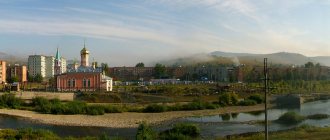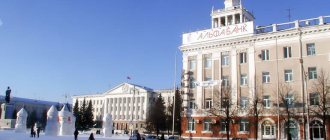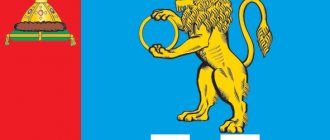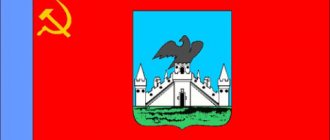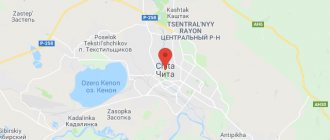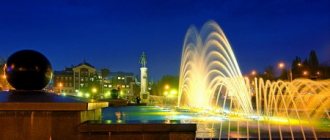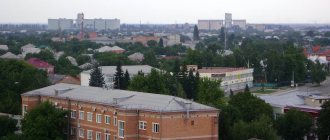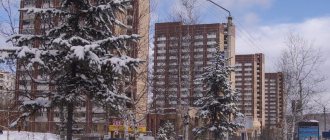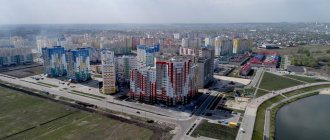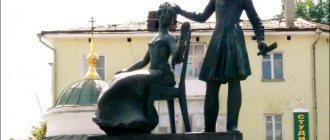Moscow Sretenskaya Theological Academy
Alexey Laushkin 11/28/201628436
Sretensky Theological Seminary, located in the center of Moscow, receives applicants from different, sometimes even the most distant corners of our vast country.
After completing their studies, many of them will return to serve God and His holy Church in their small homeland. The website of the Sretensky Theological Seminary continues the series of photo galleries of the native places of the students of our seminary. 2nd year student Alexey Laushkin entered the seminary from the Oryol Metropolis of the Russian Orthodox Church. His photo story is about the region from which he came.
Eagle
Orel is a city that arose on the site of an ancient settlement at the confluence of the Oka River and its tributary Orlik.
By decree of Ivan the Terrible in 1566, a fortress was founded here to protect against the Crimean Tatars, which laid the foundation for an amazing city. The city got its name in honor of the Orlik River. Oryol is located in the European part of the country. The distance from Moscow to the southwest is only 368 kilometers. Currently, the city of Orel is the center of the Oryol region. In 2007, Orel was awarded the title “City of Military Glory.” The coat of arms of the city of Oryol is a historical coat of arms, approved in 1781. The station square is decorated with a sculpture of an eagle - a unique landmark of the city named after this bird.
Monument to the founder of the city Ivan the Terrible
Symbol of the city of Orel on the station square
Literary capital of Russia
Oryol rightfully bears the unofficial title of one of the literary capitals of Russia. The streets and squares of the city keep the memory of the great masters of words I.S. Turgeneva, N.S. Leskova, A.A. Feta, M.M. Prishvina, I.A. Bunin and L.N. Andreeva. The population of Orel is just over 300 thousand people, but its literary heritage can cover the whole of Russia.
Monument to the writer I.A. Bunin
Monument to the writer Leskov N.S.
Monument to the writer I.S. Turgenev Nobles' Nest is a park located on the left bank of the Orlik River. Once upon a time there was the estate that I.S. Turgenev described it in his work of the same name. In 1903, a garden was opened in the park and a bust of the writer was installed. Performances were often staged in the garden, and musical concerts and general celebrations took place here. The park has been and remains a favorite vacation spot for residents of the city of Orel.
Spasskoye-Lutovinovo creative workshop of the great writer
Turgenev's house in Spassky is inextricably linked with the memory of the writer's work. A description of Spassky-Lutovinov, his shady linden alleys and surrounding areas can be found on the pages of “Notes of a Hunter” and other stories by Turgenev, which glorified the amazing beauty of the nature of the Oryol region throughout the world.
Estate of I. S. Turgenev.
Estate of I. S. Turgenev. It is worth noting that the temple has been closed since the early 30s. The exterior of the temple (with the bell tower) was restored only in the early 1970s, after which the premises were again used as a museum exhibition hall. In 2000, after restoration work, the temple was re-consecrated and opened to parishioners.
Internal structure of the Transfiguration Church in the village of Spasskoye-Lutovinovo.
Nature of the village "Spasskoye-Lutovinovo".
Autumn landscape of the village "Spasskoye-Lutovinovo".
City of the first fireworks
City Day in Orel is celebrated on August 5th. On this day back in 1943, an artillery salute was given to the troops in Moscow in honor of the liberation of the cities of Orel and Belgorod during the Battle of Kursk. This fireworks display was the first during the Great Patriotic War, so Orel and Belgorod were given the name “the city of the first fireworks.” The history of the military past of the Oryol region is reflected in the exhibitions of the military history museum.
Military History Museum
Military History Museum (side view)
Temples of the city of Orel
The spiritual life of the city's residents is closely connected with the church. The city's attractions are mostly churches, cathedrals and Orthodox churches. Oryol is a city of temples.
Epiphany Cathedral
Temple of the Smolensk Icon of the Mother of God Cathedral of the Archangel Michael
Akhtyrsky Cathedral
Oryol Orthodox Gymnasium - a pearl of the Orthodox faith for children
Since 1998, in our native Oryol region, with the blessing of His Holiness Patriarch of Moscow and All Rus' Alexy II, the Oryol Orthodox Gymnasium began its existence in the name of the Hieromartyr John Kuksha. It was in this educational institution that I studied and received a certificate of complete secondary education.
Territory of the Holy Dormition Monastery The gymnasium is located on the territory of the Holy Dormition Monastery, which is a favorable environment for children to learn the Orthodox faith. Students, young and old, actively participate in the active life of their gymnasium church.
Line on the first of September in the Orthodox gymnasium
Service in the gymnasium church
Graduates - good luck! A bright and memorable event for the students of the gymnasium was the first visit to the Oryol land of Patriarch Kirill, which took place on July 28, 2016. The gymnasium students amicably greeted the head of the Russian Orthodox Church, and then attended the patriarchal service. I still remember this event with trepidation.
Meeting of the Patriarch with students of the gymnasium and believers of the city of Oryol. The solemn service took place in the Epiphany Cathedral in the city of Orel.
Patriarchal service in the Epiphany Cathedral in Orel.
The unique nature of the Oryol region
There are many unique natural monuments located on Oryol land. One of the most amazing is the Oryol Polesie National Park. More than 30 rare plants grow on the territory of the national park. Rare species of animals such as bison, Siberian iris and many others are raised and preserved here. The main entrance to the Oryol Polesie The inhabitants of the Oryol Polesie are bison.
Nature of Oryol woodland.Alexey Laushkin
2nd year undergraduate student
Key words: My land, Orel, Orthodoxy, mission, sermon
Oryol Museum of Local Lore
Oryol Museum of Local Lore
Eagle
Founded by a scientific archival commission in 1897. One of the first provincial museums of the Russian Empire. The collection was assembled by the members of the scientific commission themselves: chain mail, an ancient Greek amphora, a spear, a collection of coins, bones of fossil animals. Today, the museum's holdings include 170 thousand unique items, including a collection of peasant costume, Oryol embroidery and lace. Since 1995, the museum has been publishing the collection “Notes of Local Lore”. For the 450th anniversary of the founding of the city, new halls were opened: ethnography, the nature of the region, the history of Orthodoxy in the Oryol region.
House-Museum of Ivan Bunin
Museum I.A. Bunina
Eagle
The path from a correspondent for the provincial newspaper “Orlovsky Vestnik” to a classic of Russian and world literature. The exposition of the Bunin Museum reveals the writer’s fate full of drama. The unique collection has been collected for more than half a century. It is based on documents from Bunin’s family and literary archives, photographs and manuscripts, letters and lifetime publications. The museum’s special pride is the writer’s Parisian office. Forty years ago, memorial furniture was delivered to Orel from the capital of France, including Ivan Bunin’s desk and his chair. Even in the “window” of the office there are not Oryol lanes, but Jacques Offenbach Street in Paris.
Oryol Regional Library named after. Ivan Bunin
Oryol Regional Scientific Universal Public…
Eagle
The oldest library in the region. It originates from the provincial public library. The book fund was seriously damaged during the fascist occupation; 80 thousand books were lost. After the liberation of the city, the library was able to be restored. Today the book depository is a methodological center for 542 district and rural libraries. The collections contain more than half a million books. Three thousand unique: including handwritten and early printed publications of the 16th–19th centuries, more than 35 thousand copies of local history literature.
Temple of the Iveron Mother of God Icon
Temple of the Iverskaya Icon of the Mother of God in Orel
Oryol Region
Built in memory of the coronation of Emperor Nicholas II near the station and at the expense of Oryol railway workers. Even the author of the project was Nikolai Orlov, an engineer of the Moscow-Kursk Railway. The Tsar himself sent a thousand rubles for construction. The main shrine of the temple was the icon of the Iveron Mother of God - a copy of the image installed on the Resurrection Gate in Moscow. After the revolution, the church building housed a school, a clinic, a kindergarten, a store, and a warehouse. In the 60s of the twentieth century, the temple was almost demolished. Only in the 90s was the building returned to the believers, and a year later daily services were resumed in the church. And three years later, a complete restoration was completed.
Oryol Museum of Fine Arts
Oryol Museum of Fine Arts
Eagle
The collection began with the collection of Anton Nikolaevich Nikolaev. The opera singer donated over 200 paintings. Oryol residents donated family portraits to the provincial museum. The Novosiltsovs, the Strakhovichs, the Skoropadskys... The “granted” portraits received by representatives of the Kurakin family from the tsars have high artistic merit. Now paintings from the 18th century can be seen in museum halls. The collection is constantly being replenished: former Jack of Diamonds, artists from the sixties, representatives of the Moscow school of the 60-80s. During expeditions to the regions of the region, a folk art fund is formed.
United Museum named after. Ivan Turgenev
Oryol United State Literary Museum I...
Eagle
Opened for the 100th anniversary of the writer, despite the post-revolutionary year of 1918. The exhibition was housed in the house of the writer’s heiress and was replenished by the Turgenev Society, formed by representatives of the Oryol intelligentsia. Forty years ago, the writer’s memorial furniture was transported to Turgenev’s Spasskoye-Lutovinovo estate, and a new exhibition “Turgenev. Life for art." The basis is a gallery of portraits of the writer, his contemporaries and books from the memorial library of Ivan Sergeevich.
Temple of the Icon of the Smolensk Mother of God
Temple of the Icon of the Mother of God of Smolensk in Orel
Oryol Region
The architectural dominant of the old city, of which only half of its original appearance has been preserved. The temple was built in the 18th century by residents of Streletskaya Sloboda - the Streltsy exiled by Peter the Great to Oryol after the riot. The church is mentioned in the works of Nikolai Leskov “Trifles of Bishop's Life” and “Council People”. In 1938, the church was closed; during the war, people hid from bombing behind the church walls, and in the post-war years, the bell tower was dismantled, and the building was given over to a bakery. Twenty years ago the church was returned to the believers. All these years, restoration has been going on, and in 2015 a new iconostasis was installed in the temple.
